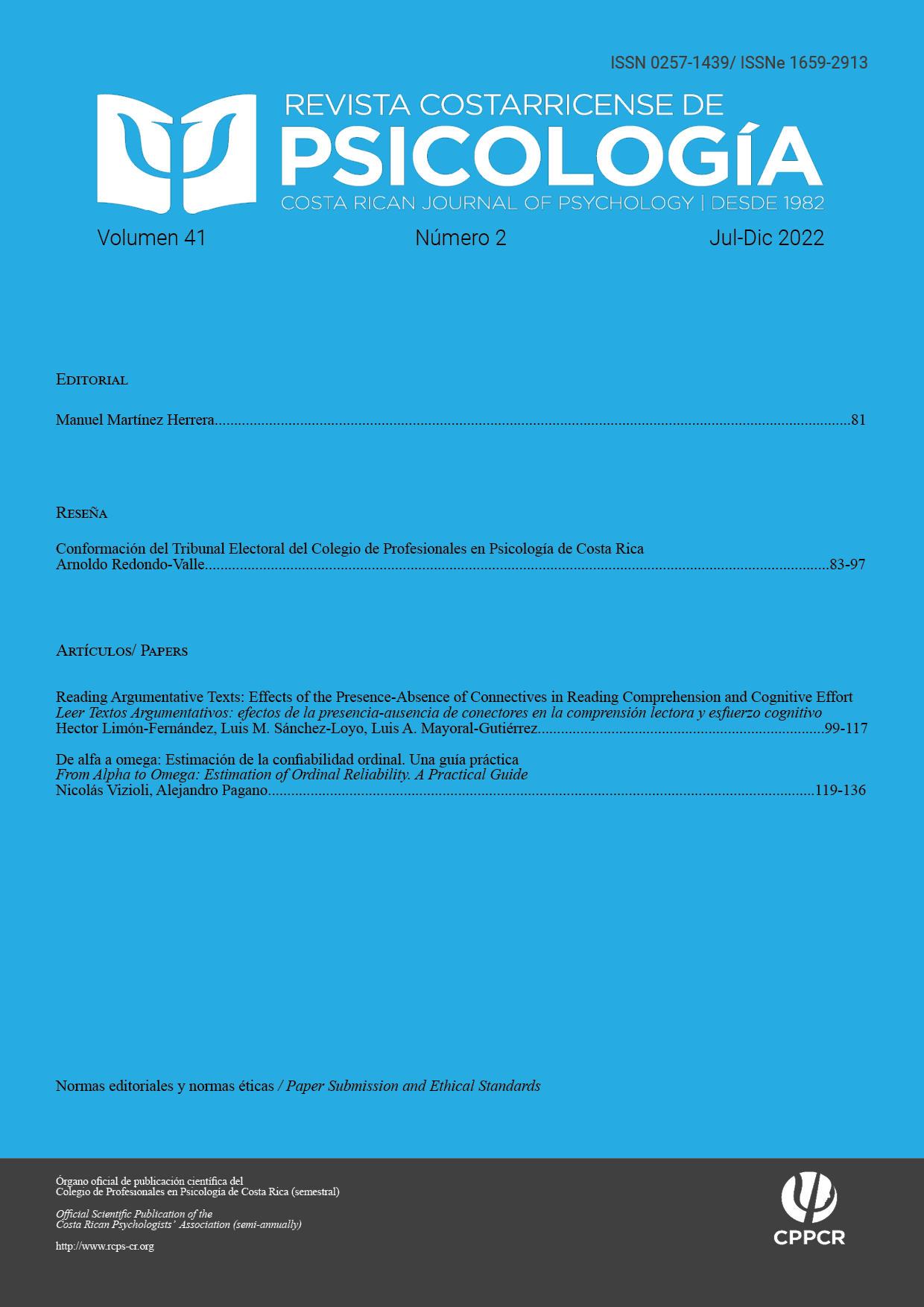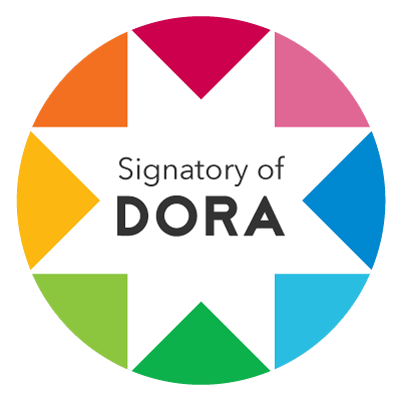De alfa a omega: Estimación de la confiabilidad ordinal. Una guía práctica
DOI:
https://doi.org/10.22544/rcps.v41i02.02Palabras clave:
confiabilidad, única administración, alfa, omega, matrices de correlaciones policoricas, R/RstudioResumen
La presente investigación realiza un recorrido por el concepto de confiabilidad como una de las propiedades psicométricas fundamentales en la Teoría Clásica de los Test. Se desarrolla el concepto y cuáles son sus diferentes aplicaciones prácticas para indagar el grado de confiabilidad de un instrumento de medición. Se centra el estudio en el cálculo de la consistencia interna a partir del alfa y el omega como los coeficientes más utilizados y la importancia de calcularlos mediante la utilización de matrices de correlaciones policoricas (MCP). Como objetivo principal se presenta una guía en español para el cálculo de coeficientes ordinales de confiabilidad al utilizar el programa R/RStudio. Se brinda un ejemplo a nivel empírico que da cuenta la relevancia de calcular este tipo de coeficientes para el cálculo de la confiabilidad de un instrumento. Al emplear una muestra de 266 adultos entre 18 y 63 años (M = 31.91, DE = 11.50), se administró la versión adaptada a argentina del Inventario de Ansiedad de Beck y el Cuestionario de Regulación Emocional. De esta manera, se exponen coeficientes para estimar la confiabilidad de los instrumentos que dan cuenta de sus ventajas y desventajas, al realizar el cálculo mediante MCP, matriz de correlaciones de Pearson y matriz de covarianzas de Pearson. A partir de los resultados, se evidencia que el cálculo mediante MCP proporcionó grados de confiabilidades mayores respecto al cálculo mediante las otras dos matrices. Se espera que el presente documento sea de importancia para investigadores no familiarizados con R.Citas
Aguirre-Urreta, M. I., Rönkkö, M., & McIntosh, C. N. (2019). A cautionary note on the finite sample behavior of maximal reliability. Psychological Methods, 24(2), 236-252. https://psycnet.apa.org/doi/10.1037/met0000176
Armor, D. J. (1973). Theta reliability and factor scaling. Sociological Methodology, 5, 17-50. https://doi.org/10.2307/270831
Beck, A. T., Epstein, N., Brown, G., & Steer, R. A. (1988). An inventory for measuring clinical anxiety: Psychometric properties. Journal of Consulting and Clinical Psychology, 56(6), 893–897. https://doi.org/10.1037/0022-006X.56.6.893
Bernaards, C. A., & Jennrich, R. I. (2005). Gradient projection algorithms and software for arbitrary rotation criteria in factor analysis. Educational and Psychological Measurement, 65, 676-696. https://doi.org/10.1177/001316440427250
Browne, M. W., & Cudeck, R. (1993). Alternative ways ofassessing model fit. En K. A. Bollen & J. S. Long (Eds.), Testing structural equation models (pp. 136-162). Sage.
Catalán, H. E. N. (2019). Reliability, population classification and weighting in multidimensional poverty measurement: A Monte Carlo study. Social Indicators Research, 142(3), 887-910. https://doi.org/10.1007/s11205-018-1950-z
Cortina, J. M. (1993). What is coefficient alpha? An examination of theory and applications. Journal of Applied Psychology, (1), 98-104. https://psycnet.apa.org/doi/10.1037/0021-9010.78.1.98
Cronbach, L. J. (1951). Coefficient alpha and the internal structure of tests. Psychometrika, 16(3), 297-334. https://doi.org/10.1007/BF02310555
Deng, L., & Chan, W. (2017). Testing the difference between reliability coefficients alpha and omega. Educational and Psychological Measurement, 77(2), 185-203. https://doi.org/10.1177%2F0013164416658325
Domínguez-Lara, S. A. (2012). Propuesta para el cálculo del Alfa Ordinal y Theta de Armor. Revista de Investigación en Psicología, 15(1), 213-217. https://revistasinvestigacion.unmsm.edu.pe/index.php/psico/article/view/3684
Domínguez-Lara, S. A. (2016). Evaluación de la confiabilidad del constructo mediante el Coeficiente H: breve revisión conceptual y aplicaciones. Psychologia. Avances de la Disciplina, 10(2), 87-94. http://www.scielo.org.co/scielo.php?pid=S1900-23862016000200087&script=sci_abstract&tlng=en
Domínguez-Lara, S. (2018). Fiabilidad y alfa ordinal. Actas Urológicas Españolas, 42(2), 140-141. https://doi.org/10.1016/j.acuro.2017.07.002
Dunn, T. J., Baguley, T., & Brunsden, V. (2014). From alpha to omega: A practical solution to the pervasive problema of internal consistency estimation. British Journal of Psychology, 105(3), 399-412. https://doi.org/10.1111/bjop.12046
Elosua, P., & Zumbo, B. (2008). Coeficientes de fiabilidad para escalas de respuesta categórica ordenada. Psicothema, 20(4), 896-901. http://www.psicothema.com/pdf/3572.pdf
Flora, D. B. (2020). Your coefficient alpha is probably wrong, but which coefficient omega is right? A tutorial on using R to obtain better reliability estimates. Advances in Methods and Practices in Psychological Science, 3(4), 484-501. https://doi.org/10.1177%2F2515245920951747
Flora, D. B., & Curran, P. J. (2004). An empirical evaluation of alternative methods of estimation for confirmatory factor analysis with ordinal data. Psychological Methods, 9(4), 466-491. https://doi.org/10.1037/1082-989X.9.4.466
Fox, J., & Bouchet-Valat, M. (2019). Rcmdr: R Commander. R package version 2.5-2. https://cran.r-project.org/web/packages/Rcmdr/index.html
Gadermann, A. M., Guhn, M., & Zumbo, B. D. (2012). Estimating ordinal reliability for Likert-type and ordinal item response data: A conceptual, empirical, and practical guide. Practical Assessment, Research, and Evaluation, 17(1), 3. https://scholarworks.umass.edu/cgi/viewcontent.cgi?article=1247&context=pare
Green, S. B., & Yang, Y. (2015). Evaluation of dimensionality in the assessment of internal consistency reliability: Coefficient alpha and omega coefficients. Educational Measurement: Issues and Practice, 34(4), 14-20.
Gross, J. J., & John, O. P. (2003). Individual differences in two emotion regulation processes: implications for affect, relationships, and well-being. Journal of Personality and Social Psychology, 85(2), 348-362. https://doi.org/10.1037/0022-3514.85.2.348
Guttman, L. (1945). A basis for analyzing test-retest reliability. Psychometrika, 10(4), 255-282. https://doi.org/10.1007/BF02288892
Hair, J. F., Black, W. C., Babin, B. J., & Anderson, R. E. (2014). Multivariate data analysis (7th ed.). Pearson Education Limited Harlow.
Hancock, G. R., & Mueller, R. O. (2001). Rethinking construct reliability within latent variable systems. En R. Cudeck, S. du Toit, & D. Soerbom (Eds.), Structural equation modeling: Present and future—A festschrift in honor of Karl Jöreskog (pp. 195-216). Scientific Software International.
Jackson, P. H., & Agunwamba, C. C. (1977). Lower bounds for the reliability of the total score on a test composed of non-homogeneous items: I: Algebraic lower bounds. Psychometrika, 42(4), 567-578. https://doi.org/10.1007/BF02295979
Jöreskog, K. G. (1994). On the estimation of polychoric correlations and their asymptotic covariance matrix. Psychometrika, 59(3), 381-389. https://doi.org/10.1007/BF02296131
Jorgensen, T. D., Pornprasertmanit, S., Schoemann, A. M., & Rosseel, Y. (2020). semTools: Useful tools for structural equation modeling (R package Version 0.5-3). https://CRAN.R-project.org/package=semTools
Kelley, K., & Lai, K. (2012). MBESS: MBESS. R package version 3.3.2. http://CRAN.R-project.org/package=MBESS
Kline, R. B. (2011). Principles and practice of structural equation modeling. Guilford Press.
Lord, F. M., & Novick, M. R. (1968). Statistical theories of mental test scores. Addison Wesley.
Lorenzo-Seva, U., & Ferrando, P. (2020). Manual of the program FACTOR v. 10. http://psico.fcep.urv.es/
Manterola, C., Quiroz, G., Salazar, P., & García, N. (2019). Metodología de los tipos y diseños de estudio más frecuentemente utilizados en investigación clínica. Revista Médica Clínica Las Condes, 30(1), 36-49. https://doi.org/10.1016/j.rmclc.2018.11.005
McDonald, R. P. (1981). The dimensionality of tests and items. British Journal of mathematical and statistical Psychology, 34(1), 100-117. https://doi.org/10.1111/j.2044-8317.1981.tb00621.x
McDonald, R.P. (1999). Test theory: A unified treatment. Erlbaum.
McNeish, D. (2018). Thanks coefficient alpha, we’ll take it from here. Psychological Methods, 23(3), 412-433. https://doi.org/10.1037/met0000144
Mikulic, I. M., (2007). Construcción y adaptación de pruebas psicológicas [Manuscrito inédito]. Facultad de Psicología, Universidad de Buenos Aires.
Moltner, A., & Revelle, W. (2015). Find the Greatest Lower Bound to Reliability. http://personality-project.org/r/psych/help/glb.algebraic.html
Muñiz, J. (2010). Las teorías de los tests: teoría clásica y teoría de respuesta a los ítems. Papeles del Psicólogo, 31(1), 57-66. http://papelesdelpsicologo.es/pdf/1796.pdf
Pagano, A. E., & Vizioli, N. A. (en prensa). Adaptación del Cuestionario de Regulación Emocional (ERQ) en población adulta de la Ciudad Autónoma de Buenos Aires y el Conurbano Bonaerense. Psicodebate. Psicología, Cultura y Sociedad.
R Development Core Team. (2020). R: A Language and Environment for Statistical Computing. R Foundation for Statistical Computing. http://www.R-project.org
Racine, J. S. (2011). RStudio: A Platform-Independent IDE for R and Sweave. Journal of Applied Econometrics, 27(1), 167–172. https://doi.org/10.1002/jae.1278
Raykov, T. (1998). Coefficient alpha and composite reliability with interrelated nonhomogeneous items. Applied Psychological Measurement, 22(4), 375-385. https://doi.org/10.1177%2F014662169802200407
Raykov, T. (2012). Scale development using structural equation modeling. In Hoyle, R. (Ed.), Handbook of structural equation modeling (pp. 472-492). Guilford Press.
Raykov, T., & Marcoulides, G. A. (2019). Thanks coefficient alpha, we still need you! Educational and psychological measurement, 79(1), 200-210. https://doi.org/10.1177%2F0013164417725127
Revelle, W. (1979). Hierarchical cluster analysis and the internal structure of tests. Multivariate Behavioral Research, 14(1), 57-74. https://doi.org/10.1207/s15327906mbr1401_4
Revelle, W. (2011). An overview of the psych package. https://citeseerx.ist.psu.edu/document?repid=rep1&type=pdf&doi=813c60673565b947fc406f480885e9f1d6694022
Revelle, W. (2020). Package ‘psych’. https://cran.r-project.org/web/packages/psych/psych.pdf
Revelle, W. (2021). How To: Use the psych package for Factor Analysis and data reduction. https://www.personality-project.org/r/psych/HowTo/factor.pdf
Revelle, W., & Zinbarg, R. E. (2009). Coefficients alpha, beta, omega, and the glb: Comments on Sijtsma. Psychometrika, 74(1), 145-154. https://doi.org/10.1007/s11336-008-9102-z
Rhemtulla, M., Brosseau-Liard, P. É., & Savalei, V. (2012). When can categorical variables be treated as continuous? A comparison of robust continuous and categorical SEM estimation methods under suboptimal conditions. Psychological Methods, 17(3), 354. https://psycnet.apa.org/doi/10.1037/a0029315
Rosseel, Y. (2012). lavaan: An R Package for Structural Equation Modeling. Journal of Statistical Software, 48(2), 1–36. http://www.jstatsoft.org/v48/i02/
Rosseel, Y. (2020). The lavaan tutorial. https://www.lavaan.ugent.be/tutorial/tutorial.pdf
Savalei, V., Reise, S. P., Vazire, S., & Fried, E. (2019). Don’t Forget the Model in Your Model-based Reliability Coefficients: A Reply to McNeish (2018). Collabra: Psychology, 5(1). https://doi.org/10.1525/collabra.247
Sijtsma, K. (2009). On the use, the misuse, and the very limited usefulness of Cronbach’s alpha. Psychometrika, 74(1), 107. https://dx.doi.org/10.1007%2Fs11336-008-9101-0
Sijtsma, K., & van der Ark, L. A. (2015). Conceptions of reliability revisited and practical recommendations. Nursing Research, 64(2), 128-136. https://doi.org/10.1097/nnr.0000000000000077
Thurstone, L. L. (1928). Attitudes can be measured. American Journal of Sociology, 33(4), 529-554. https://www.gwern.net/docs/psychology/1928-thurstone.pdf
Trizano-Hermosilla, I., & Alvarado, J. M. (2016). Best alternatives to Cronbach’s alpha reliability in realistic conditions: congeneric and asymmetrical measurements. Frontiers in Psychology, 7, Article 769. https://doi.org/10.3389/fpsyg.2016.00769
Ventura-León, J. L. (2018). ¿Es el final del alfa de Cronbach? Adicciones, 31(1), 80-81. http://adicciones.es/index.php/adicciones/article/viewFile/1037/965
Viladrich, C., Angulo-Brunet, A., & Doval, E. (2017). Un viaje alrededor de alfa y omega para estimar la fiabilidad de consistencia interna. Anales de Psicología, 33(3), 755-782. https://revistas.um.es/analesps/article/view/analesps.33.3.268401/215531
Vizioli, N. A., & Pagano, A. E. (2020). Adaptación del Inventario de Ansiedad de Beck en población de Buenos Aires. Interacciones, e171-e171. https://doi.org/10.24016/2020.v6n3.171
Zumbo, B. D., Gadermann, A. M., & Zeisser, C. (2007). Ordinal versions of coefficients alpha and theta for Likert rating scales. Journal of Modern Applied Statistical Methods, 6(1), 4. http://citeseerx.ist.psu.edu/viewdoc/download?doi=10.1.1.890.6722&rep=rep1&type=pdf
Zumbo, B. D., & Kroc, E. (2019). A measurement is a choice and Stevens’ scales of measurement do not help make it: A response to Chalmers. Educational and Psychological Measurement, 79(6), 1184-1197. https://dx.doi.org/10.1177%2F0013164419844305
Publicado
Cómo citar
Número
Sección
Licencia
Derechos de autor 2022 Revista Costarricense de Psicología

Esta obra está bajo una licencia internacional Creative Commons Atribución-NoComercial-SinDerivadas 4.0.
El Colegio, como institución editora, tiene todos los derechos reservados (copyright) sobre lo que se publica en la revista. Los autores y las autoras firman una declaración de cesión de derechos de autoría en el caso de aceptación de sus manuscritos para publicación en la revista, conforme con lo establecido en la legislación vigente.
Los artículos publicados representarán el punto de vista de su autoría y no de la revista, por lo que la autoría asume responsabilidad ante cualquier litigio o reclamación relacionada con derechos de propiedad intelectual y exonera de cualquier responsabilidad a la Revista Costarricense de Psicología y al Colegio.
La revista publicará en cada edición su política de acceso abierto (p.ej., Creative Commons). El material publicado en la revista puede ser copiado, fotocopiado, duplicado y compartido siempre y cuando sea expresamente atribuido al Colegio. El material de la revista no puede ser usado para fines comerciales.







